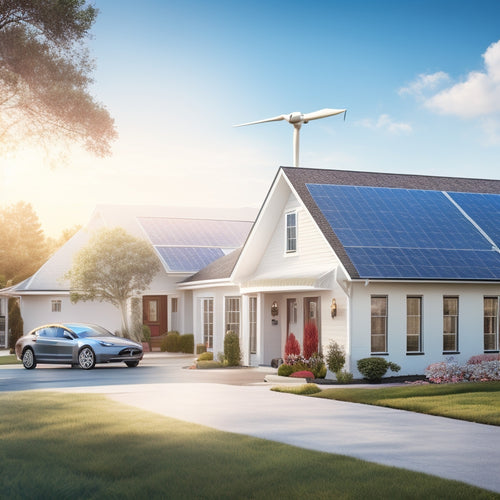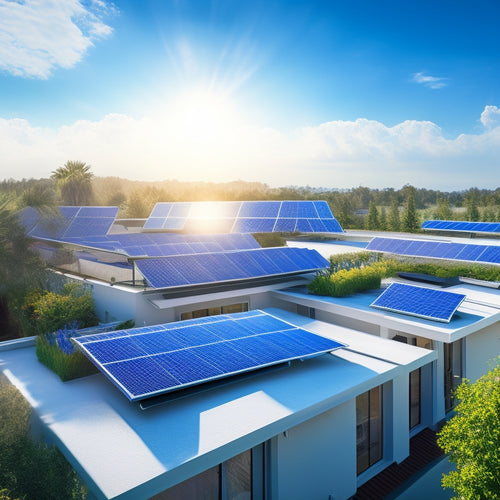
A Step-by-Step Guide to Solar Power Energy Storage
Share
You're ready to tap into the full potential of solar power by integrating energy storage into your system. To get started, you'll need to assess your energy usage patterns, determine your storage needs, and choose the right battery type for your setup. Then, you'll need to size your energy storage system, select a charge controller, and configure your inverter. After that, it's time for system installation and testing, followed by ongoing monitoring and maintenance. By following these steps, you'll be well on your way to maximizing your energy savings and reducing your reliance on the grid - and there's even more to uncover as you continue on this path.
Key Takeaways
- Assess energy usage patterns to determine necessary storage capacity and optimize energy production for grid independence.
- Select the right battery type based on chemistry, cost, and lifespan to ensure efficient energy storage and minimize environmental impact.
- Size the energy storage system correctly by evaluating energy consumption, battery size, and load management to ensure reliable backup power.
- Choose a compatible charge controller that optimizes energy harvest and ensures efficient energy management, with advanced features for monitoring and troubleshooting.
- Install and test the system with compatible components, following safety protocols and performing regular maintenance to ensure optimal performance and energy savings.
Understanding Solar Power Systems
When you decide to invest in a solar power system, it's vital to understand how it works to maximize its benefits. A solar power system consists of solar panels, an inverter, and a grid connection.
Solar panels come in different types, including monocrystalline, polycrystalline, and thin-film, each with its own efficiency and cost. You need to choose the right type of panel that suits your energy needs and budget.
The inverter converts the DC power generated by the solar panels into AC power, which is usable in your home or business.
The grid connection allows you to feed excess energy back into the grid and receive credit from your utility company. This process is called net metering.
Understanding how these components work together is fundamental to optimize your energy production and reduce your reliance on the grid.
Assessing Energy Storage Needs
Frequently, homeowners and businesses investing in solar power systems overlook a significant aspect: energy storage. However, understanding your energy storage needs is essential to guarantee a reliable and efficient solar power system.
To assess your energy storage needs, you'll need to evaluate your energy consumption patterns.
-
Analyze your usage patterns: Understand your daily energy usage, including peak demand periods, to determine the required storage capacity.
-
Conduct a load analysis: Identify the types of appliances and devices that require backup power during grid outages or at night.
-
Consider system efficiency and renewable integration: Verify your energy storage system is optimized for maximum system efficiency and integrates seamlessly with your solar power system.
- Evaluate cost considerations and environmental impact: Balance the cost of energy storage with the benefits of grid independence, backup power, and reduced environmental impact.
Choosing the Right Battery Type
You'll need to take into account two critical factors when selecting a battery for your solar power energy storage system: the type of battery chemistry that best suits your needs and the battery's deep cycle capabilities.
Battery chemistry options, such as lithium-ion, lead-acid, and nickel-cadmium, each have their pros and cons, including varying lifespans, energy densities, and maintenance requirements.
Battery Chemistry Options
Selecting the right battery chemistry is essential for a solar power energy storage system, as it directly impacts performance, cost, and lifespan.
You'll want to take into account factors like efficiency, environmental impact, and recycling options when making your decision.
Here are four key chemistry options to take into account:
-
Lithium Ion (Li-ion): Offers high energy density, long lifespan, and low self-discharge rates. Li-ion batteries are a popular choice, but they can be expensive and have limited recycling options.
-
Lead Acid: A cost-effective option with a well-established recycling infrastructure. However, lead acid batteries have lower energy density, shorter lifespans, and heavier weights compared to Li-ion batteries.
-
Flow Battery: Provides a scalable, long-duration energy storage solution with a low environmental impact. Flow batteries are well-suited for large-scale applications, but they can be complex to install and maintain.
- Nickel Cadmium (Ni-Cd): Offers high efficiency and a long lifespan, but it contains toxic heavy metals, making it a less environmentally friendly option. Solid-state innovations are emerging as a potential alternative to traditional Ni-Cd batteries.
When evaluating these options, take into account your specific energy storage needs, budget, and environmental concerns to choose the best battery chemistry for your solar power energy storage system.
Deep Cycle Capabilities
When designing a solar power energy storage system, the battery's deep cycle capabilities are essential to guarantee reliable performance and extend its lifespan. You need a battery that can handle the demands of daily charging and discharging without compromising its overall health. A deep cycle battery is designed to provide a steady flow of energy over a prolonged period, making it ideal for off-grid solar power systems.
When selecting a deep cycle battery, consider its Depth of Discharge (DOD) rating, which indicates the percentage of capacity used during each cycle. A higher DOD rating means the battery can handle more charge cycles, increasing its overall lifespan. Look for batteries with a high DOD rating, typically above 50%, to secure peak performance and battery longevity.
Additionally, consider the battery's cycle life, which refers to the number of charge and discharge cycles it can handle before its capacity degrades. A higher cycle life translates to a longer-lasting battery, reducing the need for frequent replacements and minimizing maintenance costs.
Sizing Your Energy Storage System
Determining the ideal size of your energy storage system is crucial to guaranteeing that it meets your specific needs and provides the desired backup power during outages or periods of low solar production.
You need to take into account several factors to get it right.
To determine the ideal size, think about the following:
-
Your energy usage patterns: Analyze your energy consumption habits to determine how much power you need during periods of low solar production or outages.
-
Battery lifespan: Choose a battery size that allows for a reasonable depth of discharge (DOD) to guarantee a long battery lifespan.
-
Load management: Consider the types of appliances you want to power during an outage and prioritize them accordingly.
- System configuration: Decide on the number of batteries and their configuration to guarantee efficient charging and discharging.
Selecting a Charge Controller
You'll need to choose a charge controller that matches your system's voltage and current requirements, ensuring efficient energy flow from your solar panels to your energy storage system.
There are two primary types of charge controllers to evaluate: MPPT (Maximum Power Point Tracking) and PWM (Pulse Width Modulation), each with its own strengths and weaknesses.
Choosing the Right Type
Selecting the right charge controller for your solar power energy storage system is a critical decision, as it directly impacts the efficiency and safety of your setup.
With the rapid evolution of solar technology trends and energy storage innovations, you're spoiled for choice when it comes to charge controllers. However, you need to take into account several factors to guarantee you get the right one for your specific needs.
Here are key considerations to keep in mind when choosing a charge controller:
-
Compatibility: Verify the charge controller is compatible with your solar panel array and energy storage system.
-
Voltage and current ratings: Choose a charge controller that can handle the voltage and current output of your solar panels.
-
Maximum power point tracking (MPPT): Think about a charge controller with MPPT to optimize energy harvest from your solar panels.
- Monitoring and control capabilities: Opt for a charge controller with advanced monitoring and control features to optimize system performance and troubleshoot issues.
Efficient Energy Flow
At least 95% of a solar power energy storage system's efficiency hinges on the charge controller's ability to regulate energy flow. You need a charge controller that can efficiently manage energy flow between your solar panels, battery, and load. A high-quality charge controller guarantees that your system operates within a safe and ideal range, preventing overcharging or undercharging of your batteries.
When selecting a charge controller, consider its energy management capabilities. Look for a controller that can handle load balancing, guaranteeing that the energy generated by your solar panels is distributed evenly across your batteries and load. This prevents overheating, reduces energy loss, and increases the overall lifespan of your system.
Additionally, consider the controller's maximum power point tracking (MPPT) efficiency, which should be above 95%. A high MPPT efficiency guarantees that your system can capture the maximum amount of energy from your solar panels.
Inverter Selection and Configuration
The inverter stands as a critical component in your solar power energy storage system, responsible for converting DC power from your solar panels or energy storage batteries into AC power for your home or business.
When selecting an inverter, you'll need to take into account several key factors to guarantee peak performance and compatibility.
Here are four key considerations for inverter selection and configuration:
-
Inverter types: Choose from string inverters, microinverters, or power optimizers, each with their own advantages and disadvantages. String inverters are cost-effective, while microinverters offer greater flexibility.
-
Inverter efficiency: Look for high-efficiency inverters (above 95%) to minimize energy losses. Higher efficiency means more power for your home or business.
-
Inverter compatibility: Verify the inverter is compatible with your solar panel array and energy storage batteries. Check the inverter's voltage, current, and power ratings.
- Inverter features: Take into account additional features such as monitoring capabilities, remote troubleshooting, and upgrade options. These can enhance system performance and longevity.
Remember to also think about inverter installation, troubleshooting, warranties, and potential upgrades when making your selection.
System Installation and Testing
With your inverter selected and configured, it's time to bring your solar power energy storage system to life through proper installation and testing. Verify all system components, including batteries, inverters, and mounting hardware, are compatible and meet local building codes.
Installation challenges may arise, such as limited space or complex wiring configurations, so plan carefully and consider seeking professional assistance if needed.
Conduct thorough testing procedures to verify system performance and identify potential issues. Start by testing individual components, then integrate them to verify seamless operation.
Implement safety protocols to prevent electrical shock, fire hazards, or other risks. Be prepared to troubleshoot issues that may arise during testing, such as faulty connections or software glitches.
Once your system is up and running, perform a performance evaluation to optimize its efficiency. Monitor key metrics, including energy production, storage capacity, and round-trip efficiency.
This data will help you fine-tune your system and maximize its power output. By following these steps, you'll verify a safe, efficient, and reliable solar power energy storage system that meets your energy needs.
Monitoring and Maintenance Tips
Regular system monitoring and performance tracking are essential to guarantee your solar power energy storage system operates at peak efficiency and extends its lifespan.
You'll need to employ monitoring tools to track your system's performance, identify potential issues, and enhance its operation. By doing so, you'll be able to detect any malfunctions, diagnose problems, and implement troubleshooting techniques to resolve them.
Here are some key monitoring and maintenance tasks to prioritize:
-
Schedule regular maintenance: Create a maintenance schedule to confirm your system is inspected and serviced regularly, reducing the risk of unexpected downtime.
-
Monitor battery performance: Keep a close eye on your battery's state of charge, depth of discharge, and overall health to guarantee it's operating within ideal parameters.
-
Conduct efficiency assessments: Regularly assess your system's efficiency to identify areas for improvement and enhance its performance.
- Implement safety protocols: Establish safety protocols to confirm your system is operated and maintained in a safe and environmentally responsible manner.
Maximizing Energy Savings Potential
Optimizing your solar power energy storage system's performance is essential to maximizing energy savings potential. By doing so, you'll be able to reduce your energy costs and achieve greater energy independence.
A well-optimized system also contributes to grid resilience, minimizing the strain on the grid during peak hours. Additionally, it reduces your environmental impact by maximizing the use of renewable energy.
To maximize energy savings, you can utilize financial incentives such as tax credits and rebates. Home automation systems can also be integrated with your solar power energy storage system to optimize energy usage and reduce waste.
By incorporating smart technology, you can monitor and control your energy usage in real-time, shaving peak energy consumption and reducing strain on your batteries. This, in turn, increases battery longevity and reduces the need for costly replacements.
Frequently Asked Questions
Can I Use Solar Power Energy Storage for My Electric Vehicle Charging?
You can definitely use solar power energy storage for your electric vehicle charging, leveraging solar charging to replenish your EV's battery while integrating it with your home's energy system through seamless battery integration.
How Do I Handle Energy Storage System Warranty and Support Issues?
As you venture into the unknown territory of energy storage, you'll inevitably face warranty claims and technical support issues - but you're prepared, armed with a thorough understanding of your system's warranty and a direct line to expert technical support.
Are Energy Storage Systems Compatible With Existing Electrical Infrastructure?
When you install an energy storage system, you'll need to verify it's compatible with your existing electrical infrastructure, considering grid integration and system compatibility, to avoid potential issues and guarantee seamless power flow.
Can I Add More Batteries to My System in the Future if Needed?
Flexibly fortifying your future needs, you can seamlessly scale up your battery capacity by adding more batteries, enabling system expansion to accommodate growing energy demands, and ensuring your power requirements are perpetually met.
Do Energy Storage Systems Require Any Special Permits or Licenses?
You'll need to guarantee your energy storage system meets installation requirements and regulatory compliance standards, obtaining necessary permits and licenses before setup, as local authorities may have specific rules governing energy storage installations.
Related Posts
-

Top 10 DIY Conversion Kit Reviews and Tips
You're taking the first step towards electrifying your ride, and with the right DIY conversion kit, you'll be cruisin...
-

Why Homeowners Are Embracing DIY Energy Independence
By taking control of your energy needs, you're breaking free from the uncertainty of utility bills and embracing a se...
-

Best Solar Panel Options for Maximum Energy Savings
You can maximize your energy savings with solar panels that boast efficiency ratings above 20%, paired with extensive...


